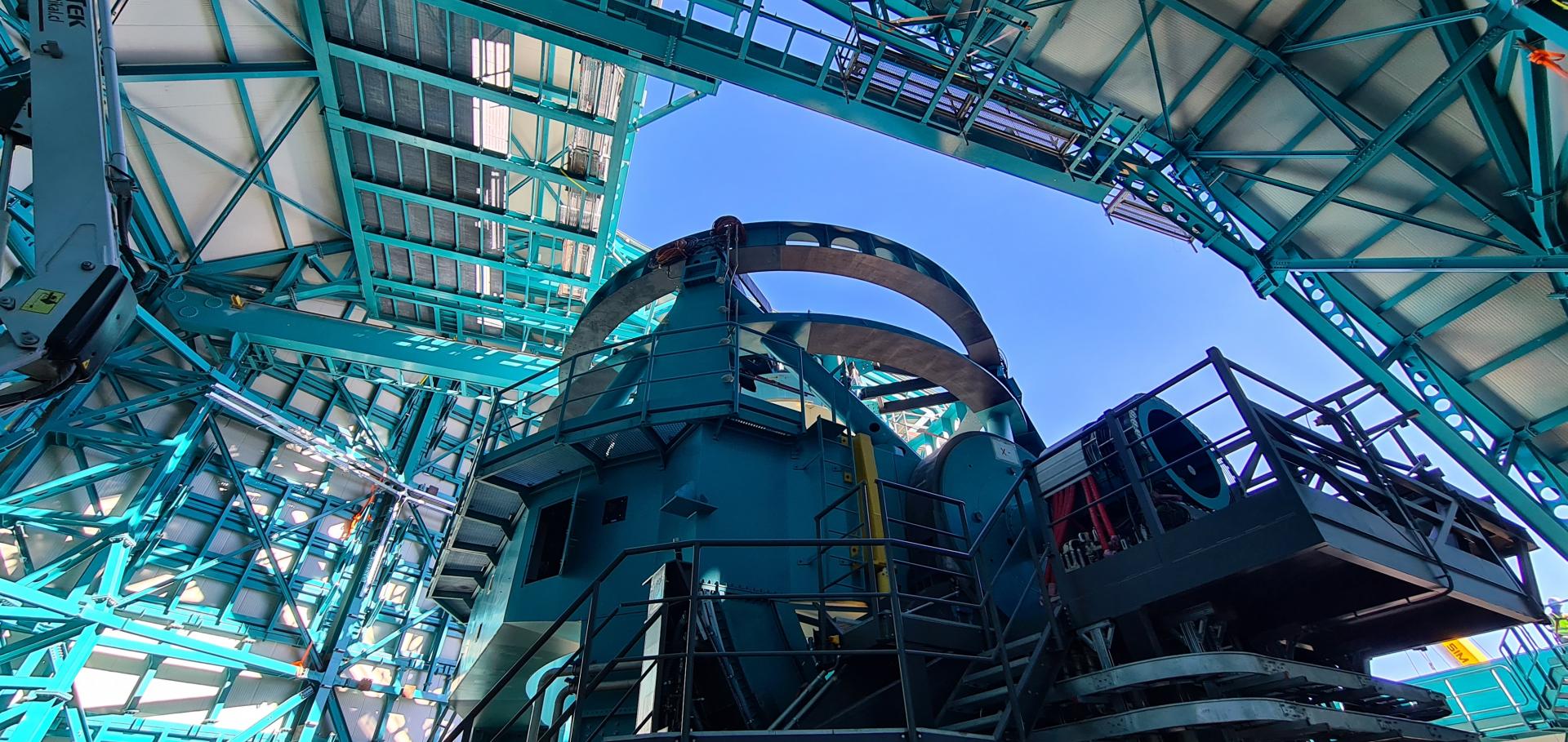Publisher’s Note: Search for hadronic decays of W and Z bosons in photon events in pp¯ collisions at s=1.96 TeV [Phys. Rev. D 80, 052011 (2009)]
Physical Review D American Physical Society (APS) 80:7 (2009) 079901
Authors:
T Aaltonen, J Adelman, T Akimoto, MG Albrow, B Álvarez González, S Amerio, D Amidei, A Anastassov, A Annovi, J Antos, M Aoki, G Apollinari, A Apresyan, T Arisawa, A Artikov, W Ashmanskas, A Attal, A Aurisano, F Azfar, P Azzi-Bacchetta, P Azzurri, N Bacchetta, W Badgett, A Barbaro-Galtieri, VE Barnes, BA Barnett, S Baroiant, V Bartsch, G Bauer, P-H Beauchemin, F Bedeschi, P Bednar, S Behari, G Bellettini, J Bellinger, A Belloni, D Benjamin, A Beretvas, J Beringer, T Berry, A Bhatti, M Binkley, D Bisello, I Bizjak, RE Blair, C Blocker, B Blumenfeld, A Bocci, A Bodek, V Boisvert, G Bolla, A Bolshov, D Bortoletto, J Boudreau, A Boveia, B Brau, A Bridgeman, L Brigliadori, C Bromberg, E Brubaker, J Budagov, HS Budd, S Budd, K Burkett, G Busetto, P Bussey, A Buzatu, KL Byrum, S Cabrera, M Campanelli, M Campbell, F Canelli, A Canepa, D Carlsmith, R Carosi, S Carrillo, S Carron, B Casal, M Casarsa, A Castro, P Catastini, D Cauz, M Cavalli-Sforza, A Cerri, L Cerrito, SH Chang, YC Chen, M Chertok, G Chiarelli, G Chlachidze, F Chlebana, K Cho, D Chokheli, JP Chou, G Choudalakis, SH Chuang, K Chung, WH Chung, YS Chung, CI Ciobanu, MA Ciocci, A Clark, D Clark, G Compostella, ME Convery, J Conway, B Cooper, K Copic, M Cordelli, G Cortiana, F Crescioli, C Cuenca Almenar, J Cuevas, R Culbertson, JC Cully, D Dagenhart, M Datta, T Davies, P de Barbaro, S De Cecco, A Deisher, G De Lentdecker, G De Lorenzo, M Dell’Orso, L Demortier, J Deng, M Deninno, D De Pedis, PF Derwent, GP Di Giovanni, C Dionisi, B Di Ruzza, JR Dittmann, M D’Onofrio, S Donati, P Dong, J Donini, T Dorigo, S Dube, J Efron, R Erbacher, D Errede, S Errede, R Eusebi, HC Fang, S Farrington, WT Fedorko, RG Feild, M Feindt, JP Fernandez, C Ferrazza, R Field, G Flanagan, R Forrest, S Forrester, M Franklin, JC Freeman, I Furic, M Gallinaro, J Galyardt, F Garberson, JE Garcia, AF Garfinkel, K Genser, H Gerberich, D Gerdes, S Giagu, V Giakoumopolou, P Giannetti, K Gibson, JL Gimmell, CM Ginsburg, N Giokaris, M Giordani, P Giromini, M Giunta, V Glagolev, D Glenzinski, M Gold, N Goldschmidt, A Golossanov, G Gomez, G Gomez-Ceballos, M Goncharov, O González, I Gorelov, AT Goshaw, K Goulianos, A Gresele, S Grinstein, C Grosso-Pilcher, RC Group, U Grundler, J Guimaraes da Costa, Z Gunay-Unalan, C Haber, K Hahn, SR Hahn, E Halkiadakis, A Hamilton, B-Y Han, JY Han, R Handler, F Happacher, K Hara, D Hare, M Hare, S Harper, RF Harr, RM Harris, M Hartz, K Hatakeyama, J Hauser, C Hays, M Heck, A Heijboer, B Heinemann, J Heinrich, C Henderson, M Herndon, J Heuser, S Hewamanage, D Hidas, CS Hill, D Hirschbuehl, A Hocker, S Hou, M Houlden, S-C Hsu, BT Huffman, RE Hughes, U Husemann, J Huston, J Incandela, G Introzzi, M Iori, A Ivanov, B Iyutin, E James, B Jayatilaka, D Jeans, EJ Jeon, S Jindariani, W Johnson, M Jones, KK Joo, SY Jun, JE Jung, TR Junk, T Kamon, D Kar, PE Karchin, Y Kato, R Kephart, U Kerzel, V Khotilovich, B Kilminster, DH Kim, HS Kim, JE Kim, MJ Kim, SB Kim, SH Kim, YK Kim, N Kimura, L Kirsch, S Klimenko, M Klute, B Knuteson, BR Ko, SA Koay, K Kondo, DJ Kong, J Konigsberg, A Korytov, AV Kotwal, J Kraus, M Kreps, J Kroll, N Krumnack, M Kruse, V Krutelyov, T Kubo, SE Kuhlmann, T Kuhr, NP Kulkarni, Y Kusakabe, S Kwang, AT Laasanen, S Lai, S Lami, S Lammel, M Lancaster, RL Lander, K Lannon, A Lath, G Latino, I Lazzizzera, T LeCompte, J Lee, J Lee, YJ Lee, SW Lee, R Lefèvre, N Leonardo, S Leone, S Levy, JD Lewis, C Lin, CS Lin, J Linacre, M Lindgren, E Lipeles, A Lister, DO Litvintsev, T Liu, NS Lockyer, A Loginov, M Loreti, L Lovas, R-S Lu, D Lucchesi, J Lueck, C Luci, P Lujan, P Lukens, G Lungu, L Lyons, J Lys, R Lysak, E Lytken, P Mack, D MacQueen, R Madrak, K Maeshima, K Makhoul, T Maki, P Maksimovic, S Malde, S Malik, G Manca, A Manousakis, F Margaroli, C Marino, CP Marino, A Martin, M Martin, V Martin, M Martínez, R Martínez-Ballarín, T Maruyama, P Mastrandrea, T Masubuchi, ME Mattson, P Mazzanti, KS McFarland, P McIntyre, R McNulty, A Mehta, P Mehtala, S Menzemer, A Menzione, P Merkel, C Mesropian, A Messina, T Miao, N Miladinovic, J Miles, R Miller, C Mills, M Milnik, A Mitra, G Mitselmakher, H Miyake, S Moed, N Moggi, CS Moon, R Moore, MJ Morello, P Movilla Fernandez, J Mülmenstädt, A Mukherjee, Th Muller, R Mumford, P Murat, M Mussini, J Nachtman, Y Nagai, A Nagano, J Naganoma, K Nakamura, I Nakano, A Napier, V Necula, C Neu, MS Neubauer, J Nielsen, L Nodulman, M Norman, O Norniella, E Nurse, SH Oh, YD Oh, I Oksuzian, T Okusawa, R Oldeman, R Orava, K Osterberg, S Pagan Griso, C Pagliarone, E Palencia, V Papadimitriou, A Papaikonomou, AA Paramonov, B Parks, S Pashapour, J Patrick, G Pauletta, M Paulini, C Paus, DE Pellett, A Penzo, TJ Phillips, G Piacentino, J Piedra, L Pinera, K Pitts, C Plager, L Pondrom, X Portell, O Poukhov, N Pounder, F Prakoshyn, A Pronko, J Proudfoot, F Ptohos, G Punzi, J Pursley, J Rademacker, A Rahaman, V Ramakrishnan, N Ranjan, I Redondo, B Reisert, V Rekovic, P Renton, M Rescigno, S Richter, F Rimondi, L Ristori, A Robson, T Rodrigo, E Rogers, S Rolli, R Roser, M Rossi, R Rossin, P Roy, A Ruiz, J Russ, V Rusu, H Saarikko, A Safonov, WK Sakumoto, G Salamanna, O Saltó, L Santi, S Sarkar, L Sartori, K Sato, A Savoy-Navarro, T Scheidle, P Schlabach, EE Schmidt, MA Schmidt, MP Schmidt, M Schmitt, T Schwarz, L Scodellaro, AL Scott, A Scribano, F Scuri, A Sedov, S Seidel, Y Seiya, A Semenov, L Sexton-Kennedy, A Sfyrla, SZ Shalhout, MD Shapiro, T Shears, PF Shepard, D Sherman, M Shimojima, M Shochet, Y Shon, I Shreyber, A Sidoti, P Sinervo, A Sisakyan, AJ Slaughter, J Slaunwhite, K Sliwa, JR Smith, FD Snider, R Snihur, M Soderberg, A Soha, S Somalwar, V Sorin, J Spalding, F Spinella, T Spreitzer, P Squillacioti, M Stanitzki, R St.Denis, B Stelzer, O Stelzer-Chilton, D Stentz, J Strologas, D Stuart, JS Suh, A Sukhanov, H Sun, I Suslov, T Suzuki, A Taffard, R Takashima, Y Takeuchi, R Tanaka, M Tecchio, PK Teng, K Terashi, J Thom, AS Thompson, GA Thompson, E Thomson, P Tipton, V Tiwari, S Tkaczyk, D Toback, S Tokar, K Tollefson, T Tomura, D Tonelli, S Torre, D Torretta, S Tourneur, W Trischuk, Y Tu, N Turini, F Ukegawa, S Uozumi, S Vallecorsa, N van Remortel, A Varganov, E Vataga, F Vázquez, G Velev, C Vellidis, V Veszpremi, M Vidal, R Vidal, I Vila, R Vilar, T Vine, M Vogel, I Volobouev, G Volpi, F Würthwein, P Wagner, RG Wagner, RL Wagner, J Wagner-Kuhr, W Wagner, T Wakisaka, R Wallny, SM Wang, A Warburton, D Waters, M Weinberger, WC Wester, B Whitehouse, D Whiteson, AB Wicklund, E Wicklund, G Williams, HH Williams, P Wilson, BL Winer, P Wittich, S Wolbers, C Wolfe, T Wright, X Wu, SM Wynne, A Yagil, K Yamamoto, J Yamaoka, T Yamashita, C Yang, UK Yang, YC Yang, WM Yao, GP Yeh, J Yoh, K Yorita, T Yoshida, GB Yu, I Yu, SS Yu, JC Yun, L Zanello, A Zanetti, I Zaw, X Zhang, Y Zheng, S Zucchelli


